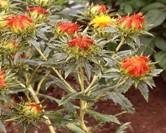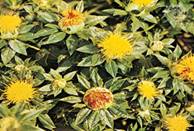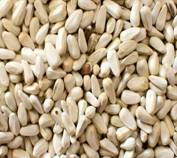AGR 301 :: Lecture 12 :: SAFFLOWER Carthamus tinctorious
![]()
Economic Importance
- Rich in PUFA (78%) – to reduce blood cholesterols
- Used for preparation of:
- Margarine, and salad dressing
- Varnishes, paints and surface coating materials
- Oil (28-32%) is also used in:
- Infant food and liquid nutrition formulations
- Effective non-allergenic dispersant for injectable medicines
- Charred oil is used to heal sores and rheumatism
- Flowers
- For dye extraction –red dye
- Cosmetics preparations
- Petals reported to have effects on circulatory systems
- Cake (30%)
- Un decorticated cake as manure
- Decorticated fed to ruminants and mono-gastric animals
- Can be as human food, if bitter principles and phenolics are removed
- Hulls (40%)can be used for manufacture of
- cellulose, insulations, abrasions, hard boards and as fuel
- Thinned young plants are used as vegetables
- since contains carotene, riboflavin and vitamins
- It is crop as border against animals
Origin and distribution
- Vavilow(1926): India, Afghanistan or Ethiopia
- De Candole (1886): Arabia
- Modern assessment:
- Area encompassing S. USSR, W. Iran, Iraq, Syria, S. Turkey, Jordan and Israel
- Distributed now:
- Between 14° & 45° N and 15° & 35° S
World scenario –safflower (million ah & million t)
Country |
Area |
Production |
Productivity |
India |
0.42 |
0.23 |
0.55 |
Canada |
0.002 |
0.002 |
1.00 |
USA |
0.086 |
0.087 |
1.02 |
Ethiopia |
0.009 |
0.006 |
0.67 |
China |
0.012 |
0.03 |
2.50 |
Australia |
0.033 |
0.036 |
1.09 |
World |
0.822 |
0.58 |
0.71 |
India Scenario – safflower
State |
Area |
Production |
Productivity (kg/ha) |
Maharastra |
263 |
159 |
605 |
Karnataka |
81 |
60 |
741 |
AP |
17 |
80 |
471 |
Orissa |
1.3 |
0.8 |
615 |
MP |
1.0 |
0.3 |
300 |
India |
364.6 |
228.6 |
627 |
- A day neutral plant
- But short day can prolong rosette stage
- Temp is more important than day length
- Thermo-sensitive
- Extremes of cold and heat not suitable
- Tolerance to low temp at vegetative
- But susceptible to high temp during flowering
- For germination 15°C
- Vegetative : 20-21°C
- Flowering: 24 to 32°C
- Rainfall at flowering affects pollination
- Excessive humidity at any stage affects
- More suitable for rabi season in India
The Plant
- Highly branched, herbaceous
- Annual height varying from 30-150cm
- Well defined fleshy tap root system
- Stem is stiff cylindrical fairly thick at base and thin at top
- Central stem branches at 15-20cm to secondary
- Each branch terminates in a flower head
- The angle of branching is varietals but can be by environment also
- The leaf deeply serrated on lower stem, short, stiff, ovate at the inflorescence
- The inflorescence – numerous florets
- Flower color may vary from whitish yellow to red-orange
- The capitula, head size may vary from 1.25 to 4.0 cm
- The fruit achene, resembles small slightly rectangular sunflower seeds
- Seed weighs 250 – 800mg/grain


- Fertile, fairly deep and well-drained
- pH range of 5-8
- Shallow soils irrespective of fertility seldom produces high yield
- In traditional belts it is black cotton soil
- On heavy soils
- This crop follows early Kharif crops
- Or may often single crop in Rabi
- It is considered as salt tolerant next to cotton
- Tolerant to Na salts but < to Ca & Mg
- Salinity reduces seed size and oil content
Seeds and sowing
Varieties
- K1 120 days, CO 1 125 days
- Bhima (33% oil) - Maharastra
- JSF 1 (30%) – Rajasthan & MP
- Manjira - AP
- Nira – (30%) Maharastra & TN
- HUS 305 (35%) for Peninsular India
Seed rate
- 7-20 kg depending upon spacing and variety
Spacing
- 45 x 15 cm in TN
- 45 x 20 cm
- 60 x 30 cm etc
Seed treatment
- Pre-sowing seed hardening
- Use fresh seeds every year
Sowing
- From last week of Sep to end of Oct
- Early sowing has advantage
- Line sowing using improved seed drill
- Ferti cum seed drill is more desirable
- Seeds can be sown behind the plough also
- Small furrow may be opened and seeds dropped and half coved
- Depth of sowing may be 5-7.5cm
- Light planking for the soils which looses moisture
Nutrient management
Rainfed crops
- N ranges from 25 kg N to 50 kg
- P2O5 – 20 to 50 kg
- K2O – Mostly not recommended
- General: 40:20:0
Irrigated
- 60:30:20 (Chatisgarh) to
- 75:75: 35 (Karnataka)
Time of fertilizer application
- Rainfed – basal – deep placed by ferti-cum seed drill
- Irrigated 50% N+ full P & K as basal
- Remaining half N at 5th week during 1st irrigation
Water management
- It is deep rooted xerophytic plant, can thrive under scarce soil moisture
- One or two irrigations (25 & 75 DAS) is optimum
- Sensitive to excess moisture at any stage
- If the soil profile contains 250mm ASM
- ET of the season is 250-300mm- no response to irrigation
- Under irrigated condition the crop may be sown under Broad beds of 1.35 to 1.8m and furrow
- To drain the excess water
- Points to remember:
- If one irrigation is possible , provide it at critical period
- Avoid contact of above ground parts with irrigation water
Weed management
- Being wider spaced
- critical periods for weed management extends up to end of rosette (25-50DAS)
- Hand weeding and hoeing
- at 20 and 35 DAS is good
- Herbicides
- PPI – Fluchloralin 0.75 to 1.0 kg
- PE – Oxadiazone – 0.75 -1.0 kg or
- PE – Pentimethalin – 0.75 kg
Important intercultural operations
- Thinning to single plant and filling the gap at the early stage (before 15DAS)
- Nipping of central shoot to induce branching
- Bird damage
- By parrots at Isolated pockets
- Cultivate in contiguous block
- Bird scaring - morning and evening during
- Seed filling to physiological maturity
Harvesting
- Duration of the crop varies due to regions
- 115-140 days
- 120-125 days in TN
- Gujarat & Orissa – 140-150days
- In cooler regions 150-180days
- Maturity
- When the lower leaves and most of the bracteoles dry and brown
- Harvest in the early hours
- Shattering minimum
- Spines relatively soft
- Combine harvester is becoming popular now since
- Manual harvesting, bundling, threshing are all becoming problematic
- Duration of the crop varies due to regions
- 115-140 days
- 120-125 days in TN
- Gujarat & Orissa – 140-150days
- In cooler regions 150-180days
- Maturity
- When the lower leaves and most of the bracteoles dry and brown
- Harvest in the early hours
- Shattering minimum
- Spines relatively soft
- Combine harvester is becoming popular now since
- Manual harvesting, bundling, threshing are all becoming problematic
- Yield
- In improved agro-techniques are used
- Under scanty moisture – 800-1200kg/ha
- Under favourable 1500-2000 kg
- Under irrigated – 1800-2800kg/ha
- Storage
- 5% moisture, clean and dry

Cropping system
- It is potential crop to replace dry rabi crops
- Wheat, coriander, linseed, chickpea, pulses
- In traditional areas it is raised as intercrops
- Sorghum, wheat, linseed, chickpea, coriander etc.
- Sequence cropping
- Farmers rarely raise more than one crop due to non availability of moisture
- There is scope for double cropping either preceding with Kharif crop or after rabi by irrigation.
Multiple choice questions
- Scientific name of safflower is ______
a. Helianthus annuus b. Carthamus tinctorious c. Sesamum indicum - Oil content of safflower is ______
a. 24-28 % b. 26-28 % c. 28-32 % - Which of the following is used for dye extraction
a. Sunflower b. Safflower c. Sesame - Total production of safflower in the world is _________ m tonnes
a. 0.93 b. 0.98 c. 0.88 - Total production of safflower in India is _________ m tonnes
a. 0.70 b. 0.43 c. 0.67 - Spacing followed for safflower in Tamil Nadu is______
a. 40 x 20 cm b. 60 x 30 cm c. 45 x 15 cm - Seed rate for safflower varies from _______ to _______ kg/ha depending upon the variety and spacing
a. 7 – 20 b. 5 – 10 c. 20 – 25 - General fertilizer recommendation for rainfed safflower is ______ kg NPK /ha
a. 60:30:20 b. 40:20:0 c. 75:75:35 - Saturated fatty acid content in safflower is ________
a. 12 % b. 15 % c. 10 % - Mono unsaturated fatty acid content in safflower is ________
a. 12 % b. 15 % c. 14 %
| Download this lecture as PDF here |
![]()